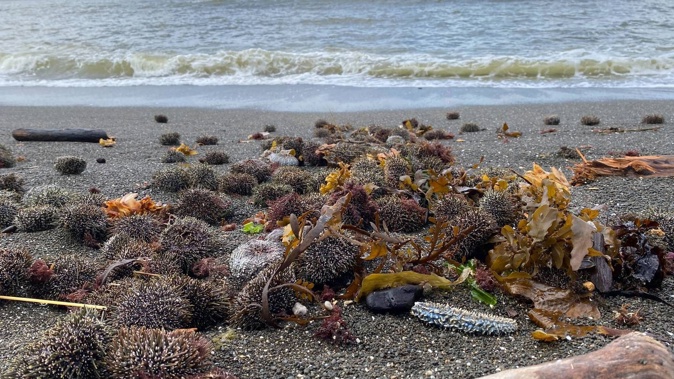
The algal bloom that dominated the Hawke’s Bay coastline for about two months might have done its final dash by depositing thousands of dead sea creatures on Napier’s Ahuriri beach.
Test results show the bloom was almost certainly to blame for mass deaths of kina as well as crayfish, starfish and sea cucumber which washed ashore at Hardinge Rd, including Sandy Beach, and on a small part of Westshore Beach eight days ago.
Small quantities were also found on the northeast-facing beaches of Te Awanga and Haumoana.
It sparked public warnings to not touch or consume the bounty while it was unknown how the phenomenon had happened, although numerous gatherers had already bagged their take before the warning.
Hawke’s Bay Regional Council science manager Anna Madarasz-Smith said algal samples had come back from the laboratory on Thursday, indicating the bloom that had been sitting off the shores for more than two months had now “collapsed”.
“Where we had numbers of blooming algal cells over 33 million cells per litre of water, they are currently sitting at below 1000 cells per litre,” she said.
The algal bloom that prevailed across Hawke Bay for more than two months is likely to have killed thousands of small sea creatures. Photo / Paul Taylor
“This is increasingly supportive of our theory that the bloom caused low dissolved oxygen in the bottom waters and resulted in stress and death for the marine species living on the seafloor,” Madarasz-Smith said.
Testing the day after sealife washed ashore showed dissolved oxygen was regularly below 30-40 per cent (normal range is 90-110 per cent) with high levels of “salinity driven stratification”, which prevents mixing and re-oxygenation of the water.
The bloom was first noticed in mid-November, and brought red and brown seas by day and a return of the bioluminescent night-glow in waves from Westshore to Haumoana.
Take your Radio, Podcasts and Music with you

/cloudfront-ap-southeast-2.images.arcpublishing.com/nzme/42VFO47A4NHY7AWOXRNAPVVRMM.JPG)








